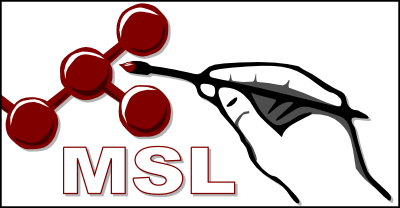Difference between revisions of "Main Page"
(→Reference) |
|||
| Line 45: | Line 45: | ||
=== Reference === | === Reference === | ||
| − | + | Article published using MSL should cite: | |
| − | '''MSL in the | + | Kulp DW, Subramaniam S, Donald JE, Hannigan BT, Mueller BK, Grigoryan G and Senes A |
| − | <pubmed>21482808 | + | "Structural informatics, modeling and design with an open-source Molecular Software Library (MSL)" |
| − | + | ''J. Comp. Chem.'' (2012) '''in press''' | |
| − | + | ||
| − | < | + | '''MSL has been used in the following work:''' |
| + | <pubmed>21482808 21321234 20945900 20080739 19722646</pubmed> | ||
| + | <!-- 21287621 --> | ||
Revision as of 20:34, 5 March 2012
MSL: an open source C++ library for analysis, manipulation, modeling and design of macromolecules.
Contents
Reference
Kulp DW, Subramaniam S, Donald JE, Hannigan BT, Mueller BK, Grigoryan G and Senes A "Structural informatics, modeling and design with an open-source Molecular Software Library (MSL)" J. Comp. Chem (2012) in press
Philosophy
The main goal is to create a set of tools that enable the computational study of macromolecules with relative ease at all levels, from simple operations (for example, load a PDB and measure a distance or edit a dihedral) to complex applications (protein modeling or design).
The MSL library is not a program (although some applications are distributed) but a tool for scientist to code their own methods.
Features
Some of the features supported by the library are:
- Support for reading and writing PDB files.
- The ability of storing and switching between multiple atom coordinates, for conformational changes and rotameric representation of side chain conformational freedom.
- For protein design, the ability to build and store multiple residue identities (i.e. LEU, ILE, ALA) at a position and switch between them.
- Transformations such as translations, rotations, and alignments.
- The CHARMM force field and other potential energies.
- Support for CHARMM topology and parameter files.
- Structure building from scratch (using internal coordinates)
- Search algorithms such as Monte Carlo, Dead End Elimination, and Self Consistent Mean Field Monte Carlo.
- Local backbone sampling.
- Crystal lattice generation.
- A PyMOL Python Interface for calling MSL code from within PyMOL.
- A R Interface for calling arbitrary R algorithms or plotting routines from within MSL
- And more...
Documentation
The Documentation – currently still under construction – provides a description of the objects and of some distrubuted programs and utilites. A step by step tutorial is being assembled.
Status
The libraries are in an advanced alpha stage and in active development. They are suitable for production work (at your own risk, we use them for it daily), but the APIs are not set in stone so the occasional bug will surface and feature development will be ongoing.
Source
The source code can be downloaded on SourceForge. Go to the Download page. ("To do" list).
Main development team:
- Senes Lab, U Wisconsin-Madison: Alessandro Senes (senes _AT_ wisc.edu), Sabareesh Subraminiam (subramaniam2 _AT_ wisc.edu)
- The Scripps Research Institute, La Jolla, Ca: Dan Kulp (dwkulp _AT_ scripps.edu)
- DeGrado Lab, U Pennsylvania: Brett Hannigan (brettth _AT_ mail.med.upenn.edu), Jason Donald (jdon _AT_ mail.med.upenn.edu)
Reference
Article published using MSL should cite:
Kulp DW, Subramaniam S, Donald JE, Hannigan BT, Mueller BK, Grigoryan G and Senes A "Structural informatics, modeling and design with an open-source Molecular Software Library (MSL)" J. Comp. Chem. (2012) in press
MSL has been used in the following work:
Ivan V Korendovych, Daniel W Kulp, Yibing Wu, Hong Cheng, Heinrich Roder, William F DeGrado
Design of a switchable eliminase.
Proc Natl Acad Sci U S A: 2011, 108(17);6823-7
[PubMed:21482808]
##WORLDCAT## [DOI]
(I p)
Jason E Donald, Yao Zhang, Giacomo Fiorin, Vincenzo Carnevale, David R Slochower, Feng Gai, Michael L Klein, William F DeGrado
Transmembrane orientation and possible role of the fusogenic peptide from parainfluenza virus 5 (PIV5) in promoting fusion.
Proc Natl Acad Sci U S A: 2011, 108(10);3958-63
[PubMed:21321234]
##WORLDCAT## [DOI]
(I p)
Ivan V Korendovych, Alessandro Senes, Yong Ho Kim, James D Lear, H Christopher Fry, Michael J Therien, J Kent Blasie, F Ann Walker, William F Degrado
De novo design and molecular assembly of a transmembrane diporphyrin-binding protein complex.
J Am Chem Soc: 2010, 132(44);15516-8
[PubMed:20945900]
##WORLDCAT## [DOI]
(I p)
Bryan W Berger, Daniel W Kulp, Lisa M Span, Jessica L DeGrado, Paul C Billings, Alessandro Senes, Joel S Bennett, William F DeGrado
Consensus motif for integrin transmembrane helix association.
Proc Natl Acad Sci U S A: 2010, 107(2);703-8
[PubMed:20080739]
##WORLDCAT## [DOI]
(I p)
Yao Zhang, Daniel W Kulp, James D Lear, William F DeGrado
Experimental and computational evaluation of forces directing the association of transmembrane helices.
J Am Chem Soc: 2009, 131(32);11341-3
[PubMed:19722646]
##WORLDCAT## [DOI]
(I p)
